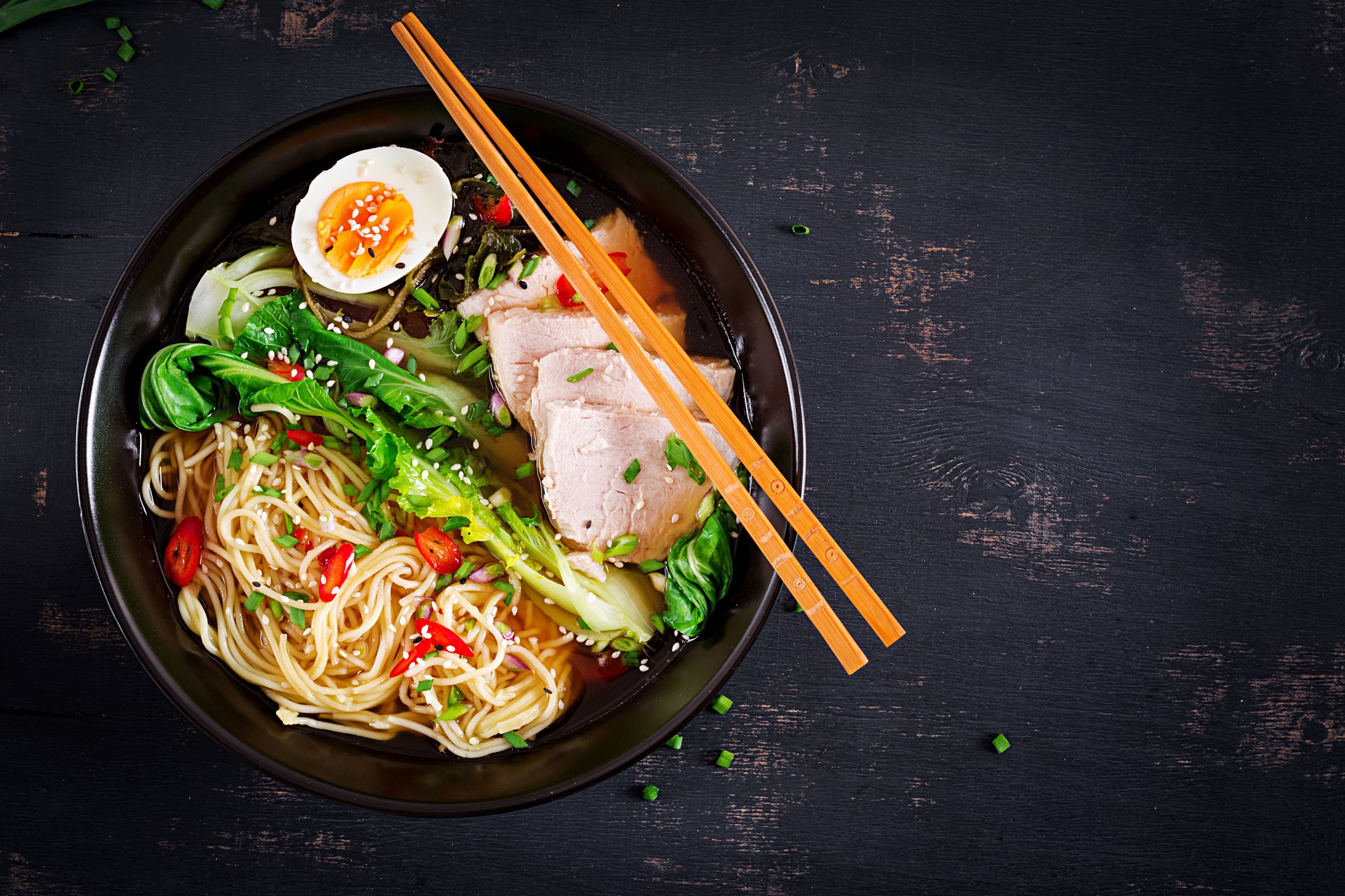
Raise your hand if you like JAPAN!!!!! Yeah, me too, who doesn’t right?
If you’re like me and you’re wondering which are the most famous, common or easy to find types of Japanese food then this is a post for you.
Let’s get right into it, this is a Japanese Food Guide
1-Sushi
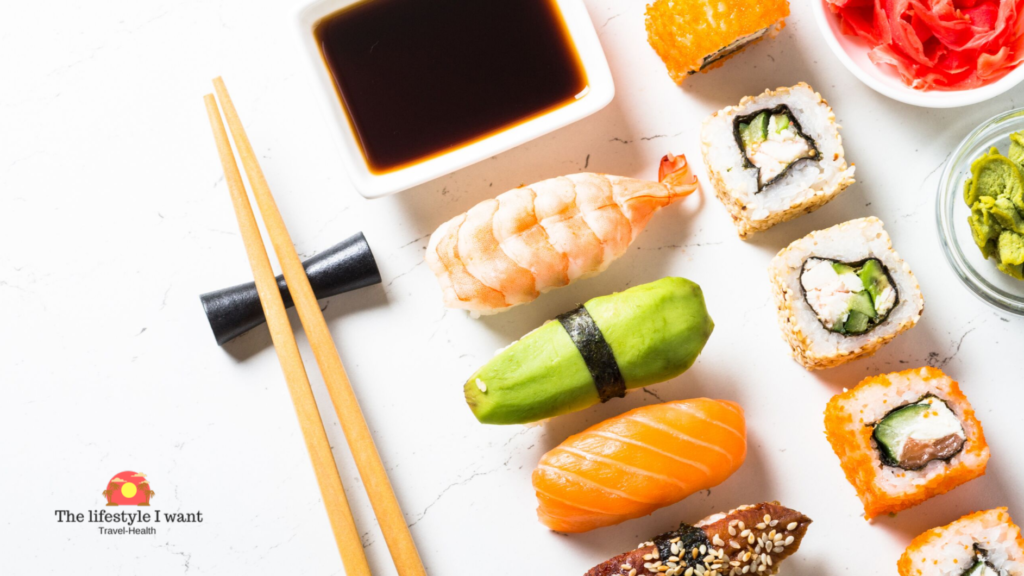
This could be the most famous Japanese dish in the whole world right? Well at least one of them. They come in different colors and different flavors, and one thing is for sure, you’ll be left asking for more.
The dish is said to have originated in South East Asia. It was until the Edo period in Japan (1603-1868) that the dish was made popular all over Japan. Sushi rice is vinegared rice, with a little bit of salt and sugar.
Sushi ingredients and shapes vary widely, but the most common ingredients are seafood, vegetables and some times tropical fruits.
How healthy is Sushi?
It depends. If you go for the more traditional type then the main ingredients will be raw fish and rice, both are naturally low in fat and high in protein and carbohydrates. The latter is only in the rice.
When vegetables are added to Sushi, vitamins, and minerals are being added. Some seafood is high in omega 3 fatty acids which may have a good effect on cardiovascular health, so yeah Sushi is healthy.
Unless you go for the not so traditional Sushi, you know the ones that are made with fried shrimp and a lot of mayonnaise, that’s not healthy.
The best Sushi restaurants in Japan
I think it would be a Titanic task to go to every single Sushi restaurant in Japan and make the final decision on which are the absolute best. I certainly did not do that.
But here’s a list of the best Sushi restaurants in Tokyo, Osaka, and Fukuoka, based on public reviews.

2-Sashimi
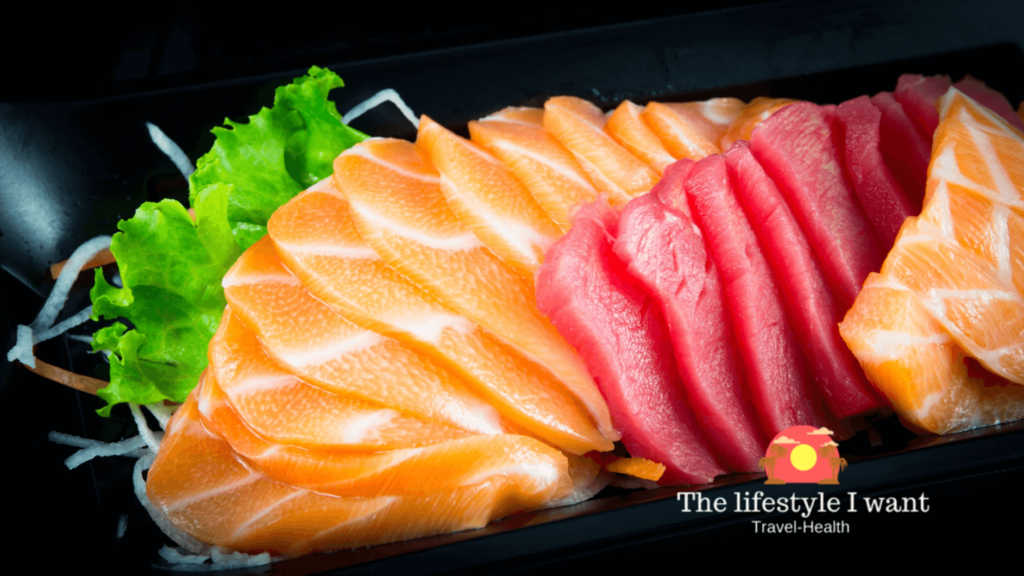
The cousin of Sushi, it’s similar to Sushi but not quite the same, mainly because there’s no rice. It’s possible to be served Sashimi and rice, but on separate plates.
The most common way to eat Sashimi is by dipping it in soy sauce and putting it in your mouth, it’s that simple. Sashimi is not just seafood, there is also beef Sashimi and even beef liver Sashimi.
Just like in Sushi there are different varieties. What is there in Sashimi? It’s just fresh raw fish or meat, there’s a lot of variety in the way it’s cut. It can be very thin slices, thick or in cube shapes.
Some Sashimi, like octopus Sashimi, is cooked due to its chewy nature.
Is Sashimi Healthy?
Considering that Sashimi is pretty much raw, sometimes it might be slightly boiled to avoid risks of infections, it’s safe to say is healthy as there’s no oil or breading added to it.
Tuna and Salmon Sashimi are particularly high in omega 3 and proteins and have low-calorie content.
3-Ramen
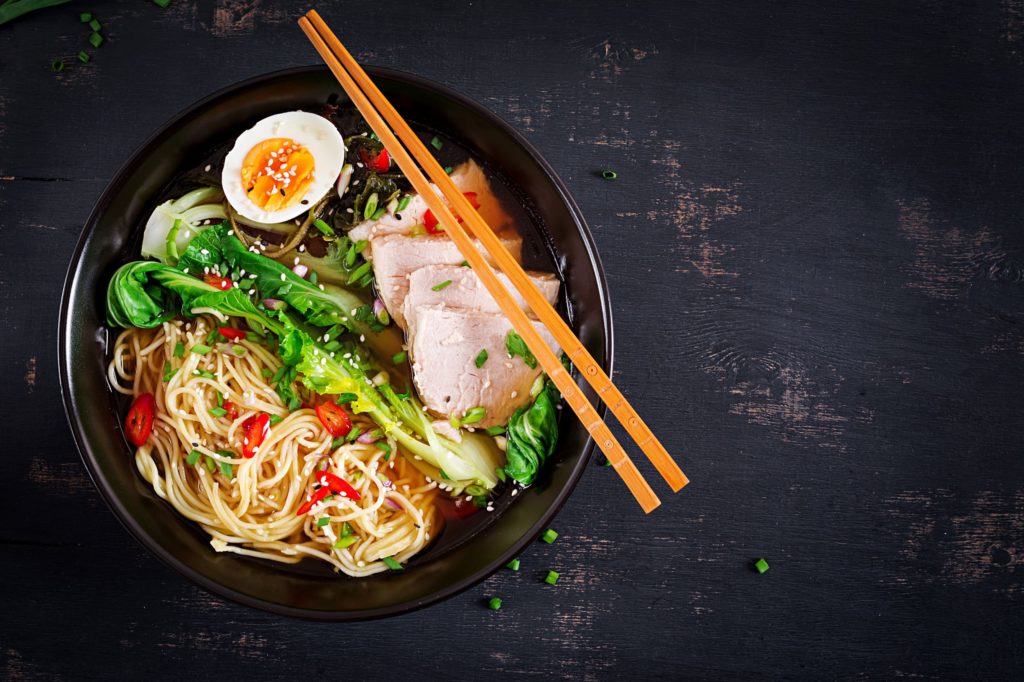
This staple dish from Japanese cuisine actually has its roots in northern China. The most accepted theory is that Ramen was introduced to Japan by Chinese immigrants in the late 19th century in Yokohama, China Town.
After the end of world war 2, Japan had one of the worst rice crops ever recorded, and the USA, they were occupying Japan at the moment, introduced a lot of cheap wheat flour to the market to help cope with the lack of food.
It was like this that Ramen became a very popular dish in Japan, and bread too.
The dish is made out of noodles, soup, which is usually made of stock based on chicken or pork, and is also mixed with other ingredients such as onions, baby sardines, tuna flakes, among other things.
There’s also vegetable-based broth for vegetarians
Is Ramen Healthy?
Well, I would say this is a bit more difficult to settle since ramen bowls can be so different from each other in terms of ingredients.
There are a couple of publications out there that have tried to answer this question and they conclude that even though is not easy to make a final conclusion, Ramen tends to be high in sodium, low in protein and high in carbs.
The above doesn’t sound super healthy to me, to anyone who’s trying to build muscles and lose weight you should stay away from carbs and eat protein. Although I don’t think eating Ramen from time to time is bad.
4-Okonomiyaki
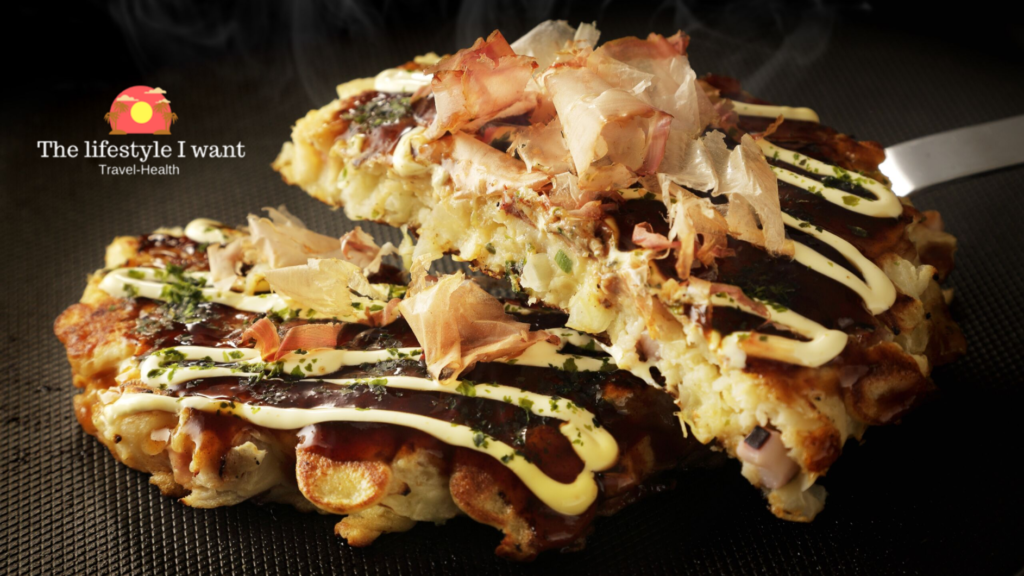
Okay, now we’re moving into the not so popular Japanese food, although this one is still fairly renown, Okonomiyaki, or how I call it, the Japanese pancake.
This is yet another type of Japanese food where ingredients can vary greatly from region to region in Japan.
The basic batter for the pancake is made out of flour, grated yam, water, eggs, and shredded cabbage, those are the basic ingredients, after that, it all depends on which style you get to choose from, it could include fish or even noodles.
In Osaka, where the dish is supposed to have originated, the dish is cooked like a pancake. It’s pan-fried and two spatulas are used to flip it and then cut it into pieces before serving.
Is Okonomiyaki healthy?
Let’s see, Okonomiyaki has eggs, vegetables, meat or seafood, and other toppings, and is pan-fried, so yes, it is healthy, whatever variation you choose will most likely be high in protein and other vitamins and minerals.
There are regions in Japan where they add a large amount of cabbage which is abundant in dietary fiber, great for digestion.
5-Takoyaki
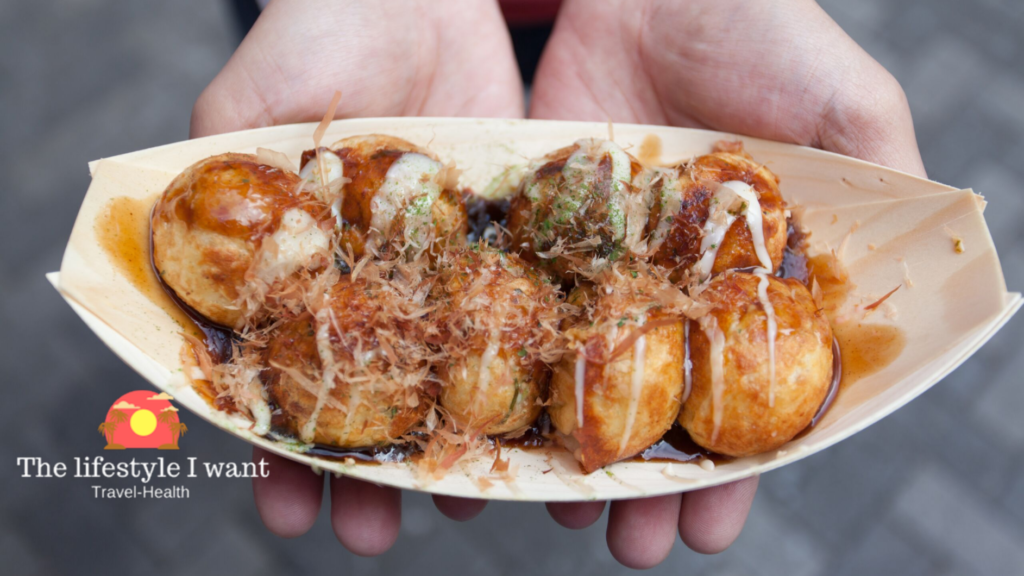
This is more of Japanese snack, very popular street food as well. This ball shape appetizer is made of wheat flour-based batter and cooked in a special molded pan.
The filling of Takoyaki is usually minced or diced octopus, pickled ginger and green onions. The balls are brushed on top with Takoyaki sauce
Takoyaki is said to have originated in Osaka, by a street vendor named Tomekichi in 1935. Something that’s very particular about this dish is that it requires a specially shaped pan to cook it.
Is Takoyaki Healthy?
Let’s see, Takoyaki is made out of batter that contains eggs and wheat and in the inside has octopus and a few vegetables, oh and it requires some oiled to be cooked.
The only ingredients you might argue are not healthy is the wheat and the oil, but come on Takoyaki is not a big dish, some small bite-size waffle-like snacks won’t ruin your diet.
6-Ebifurai
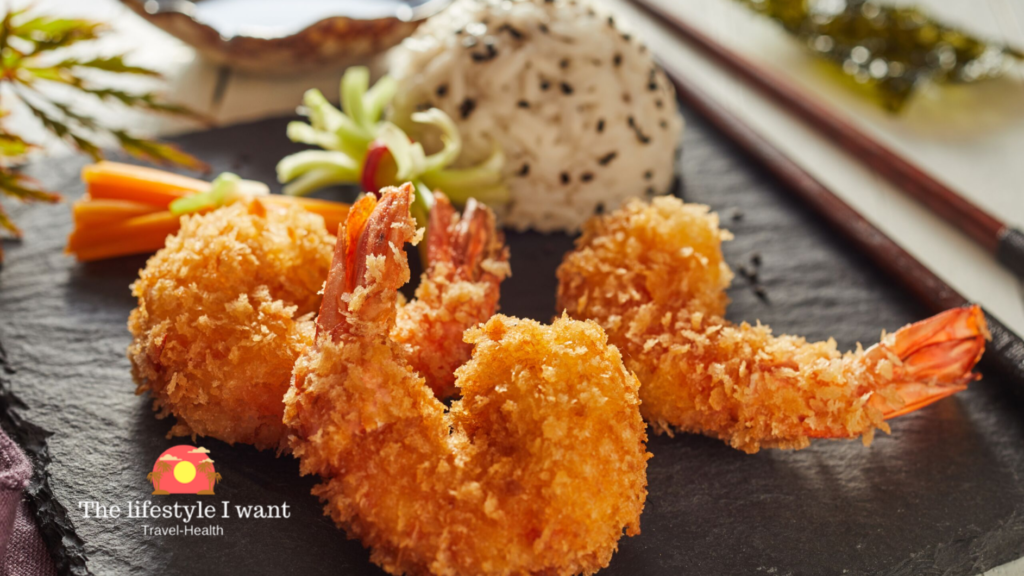
Okay let’s make this clear right away, Ebifurai is deep-fried so is not healthy but man they’re good.
This dish is popular in Japan and in many Japanese restaurants around the world, the most common shrimp used for it is the black tiger shrimp and is said to have originated around the year 1900.
Cooking this is easy, some restaurants will straighten the shrimp out and pull the digestive track out, then they coat the shrimp with flour, beaten egg and bread crumbs, then they deep fry the shrimp.
You can find many variations or similar dishes in other Asian countries such as Korea and the Philippines.
7-Oden
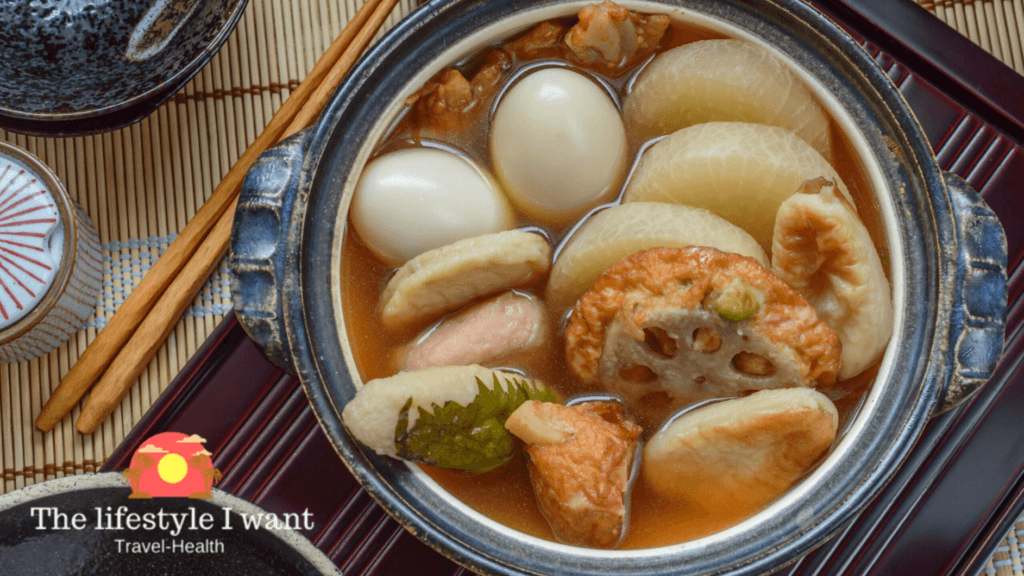
This might be one you haven’t heard of if you haven’t been to Asia, is not just popular in Japan, is also popular in Taiwan and China.
Oden consists of different food that’s been boiled in a mildly flavored broth. It’s considered to be a winter food for some, but you can find this food year-round in Japan.
It’s common to find Oden in night markets offered by street sellers. There are also restaurants and pubs selling it, you can even find it in convenience stores.
The way you usually go about ordering or buying this dish is by selecting only the food you’d like and put it in a small bowl or paper cup and add some of the broth, then you’ll be charged based on what you got.
Common ingredients are eggs, radish, konjec, processed seafood cakes, tofu, and corn.
Is Oden healthy?
It really is, first of all, everything is boiled in a broth that is almost water, and the ingredients are eggs, seafood, and vegetables, this is what you call a low in fat and high in nutrients dish.
In Taiwan Oden is also popular and you’ll find it in most convenience stores such as Family Marts and 7-11
8-Yakisoba
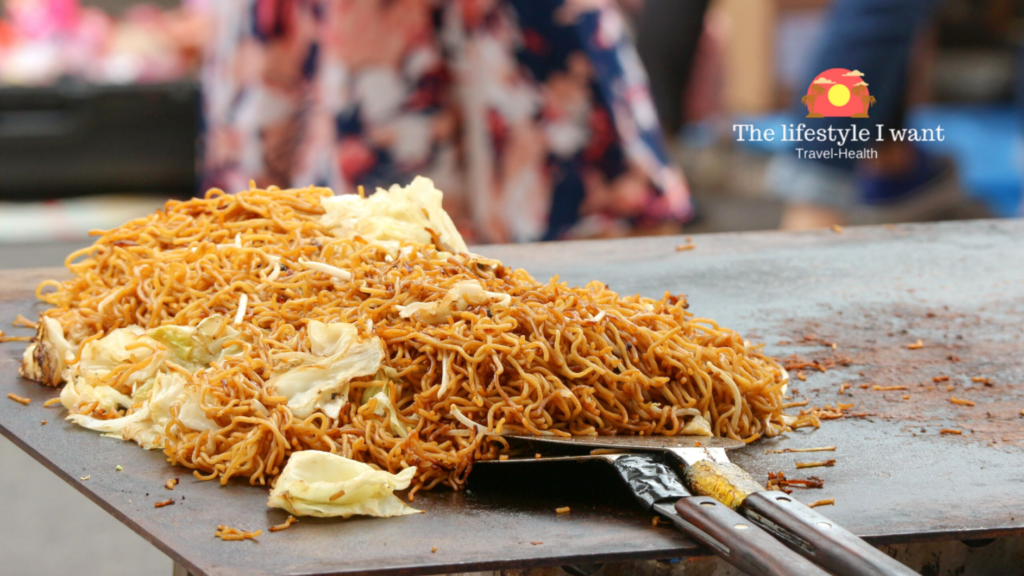
I do enjoy eating this one very much. It’s both tasty and cheap, Nomadic Matt recommends it as a budget dish in his Japanese travel guide.
Yakisoba is basically a mixture of ramen style noodles combined with tiny pieces of pork and some chopped vegetables such as cabbage. It’s also mixed with something similar to oyster sauce, that’s how it gets its flavor and color.
This is a very common street food dish and you can also find it in some restaurants.
Interesting fact, Yakisoba can sometimes be served on top of a hot dog.
Is Yakisoba healthy?
A portion of Yakisoba for one person will be around 250 calories. It’ll be heavy on carbs and will contain a bit of protein thanks to the meat in it, some nutrients might be added if you mix it with vegetables.
As part of a balanced diet, eating Yakisoba once or twice per week shouldn’t represent any major health risk.
9-Dango
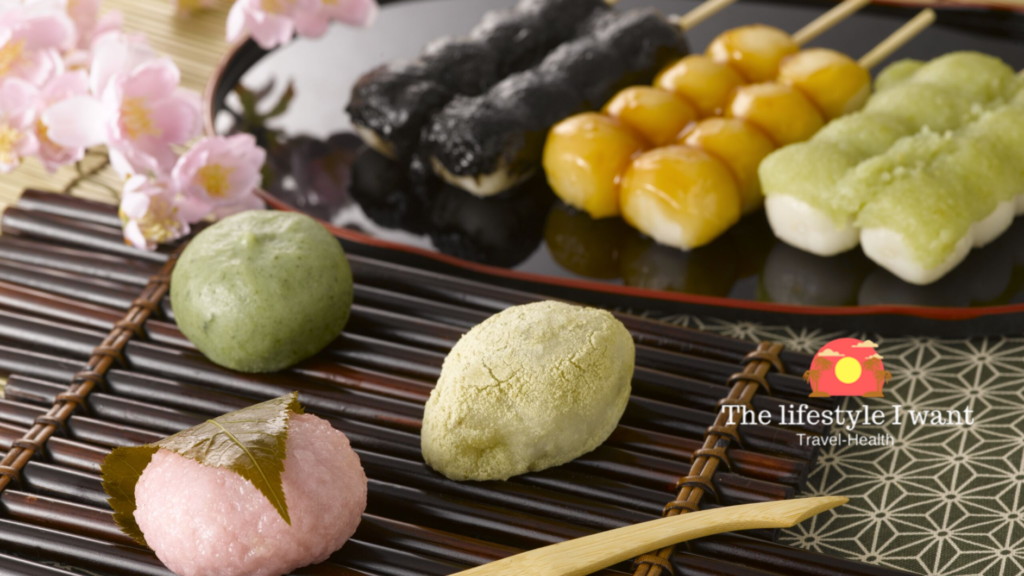
Aha!!! I bet this is one you don’t hear about every day, or maybe yes I don’t know who you are.
This sweet Japanese food is said to have its origins in Kyoto. Four to five balls are served in a skewer just like in the picture above. Dango is made from mochiko, which is rice flour.
You can find Dango in Japan year-round, although some special flavors can only be found during some seasons. There are different varieties of Dango, they’re mainly differentiated by the main ingredient which provides the flavor.
Some popular ingredients are eggs, green tea, red beans, potatoes, and chestnuts.
Is Dango healthy?
You might be thinking, okay if this is dessert then it must not be good, well think again, desserts in Japan and other Asian nations are not the same as western desserts.
Even though they might be a bit high in calories, there are some options which are very low in fat and high in nutrients, Dango is one of those options, so don’t be afraid to eat it.
10-Sukiyaki
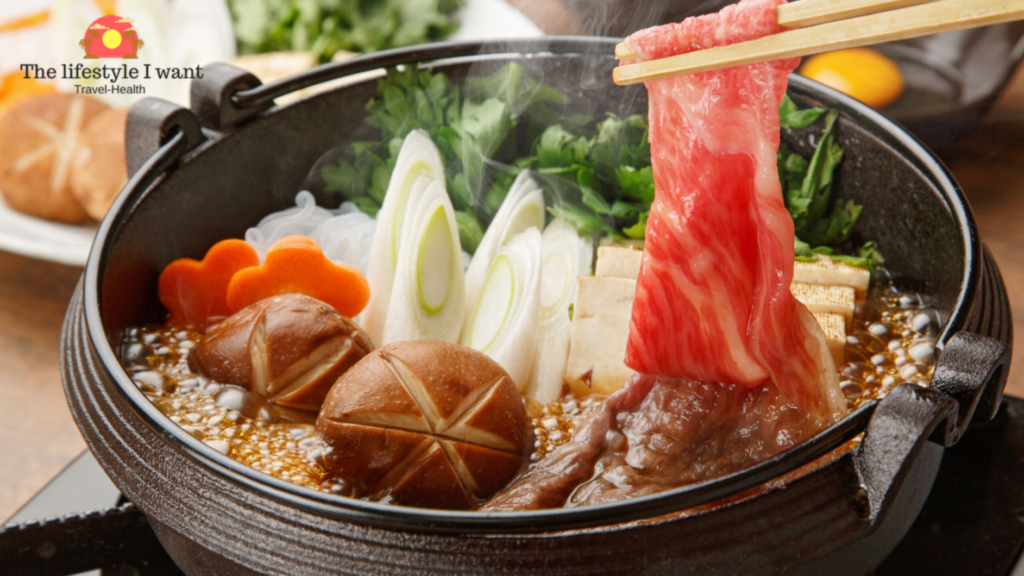
This is also known as hot pot. It’s supposed to be a winter dish but you can find it in many restaurants all year round. Something peculiar about this dish is that you have to cook it yourself.
You will usually be asked what kind of flavored broth you’d like and they’ll put it in a pot in front of you, then they’ll light the fire, you wait for it to start boiling and then you throw the ingredients in.
You will also get to choose what you want to eat, you can choose seafood, different cuts of beef and different types of vegetables.
There is one thing that makes sukiyaki different from a traditional hot pot, like the one you can find in China and Taiwan, which is that, after the food is done cooking, you’ll have a bowl of raw egg next to you where you’re supposed to dip the food a little bit.
Is Sukiyaki healthy?
Well, it is, it’s a bunch of meat, seafood, and vegetables put in a pot and boiled, this is a dish low in calories and fat and high in protein and other nutrients.
Although, in some sukiyaki and hot pot restaurants is common to get free rice and ice cream, so be careful with that.
Healthy additions to your post-workout shake.
11-Natto
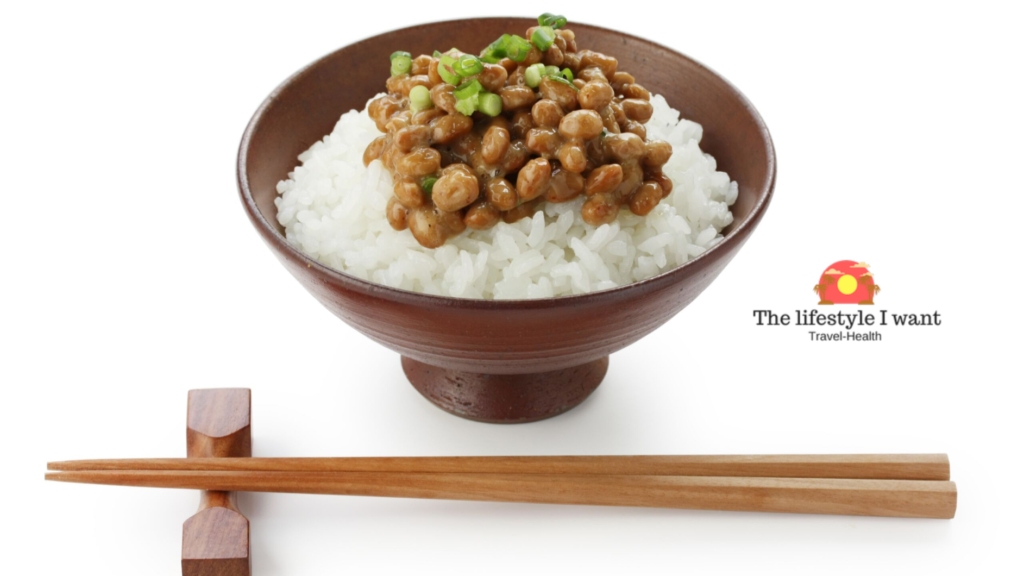
This is one you either love or hate, or maybe is one that you will definitely hate and only if you eat it many times ( I don’t know why you’d do that) you’ll love.
This is made out of fermented soybeans and is -hear this- a breakfast dish, nothing is better than the taste of fermented soybeans at 7:00 a.m., right? In a 2009 survey, 70% of Japanese people said they enjoy eating it.
And some who said they dislike it said they eat it anyway for its nutritional value. Natto is sticky and slimy, is usually served with rice or green onions.
Is Natto healthy?
I think this might be the healthiest food in the list, Healthline called it super healthy and nutritious, if they did then it’s settled I guess. Natto is high in protein and other nutrients, the fermentation process actually decreases its antinutrients.
12-Onigiri
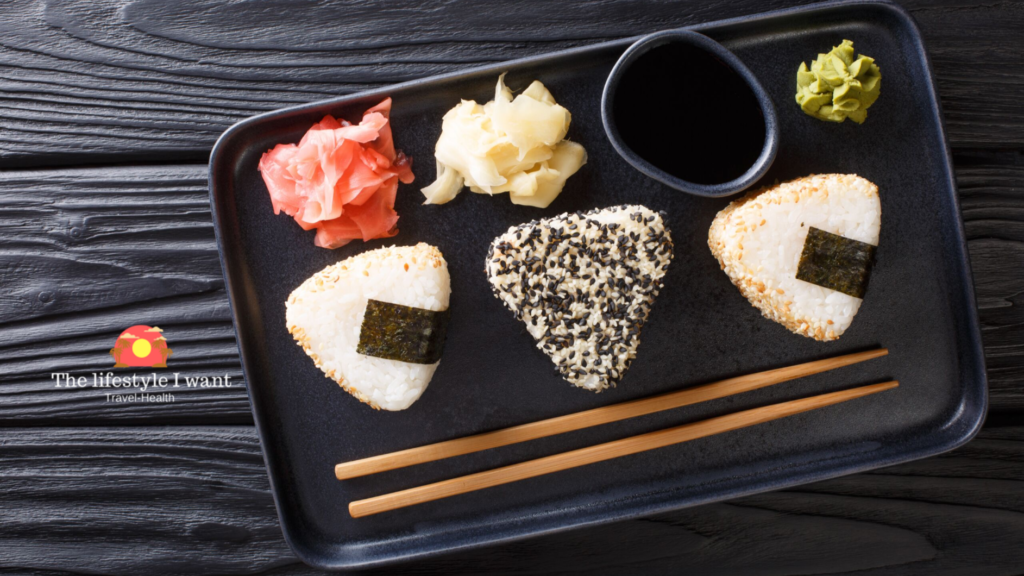
If you don’t like Onigiri then don’t talk to me ….. It’s one of my favorite Japanese food. Onigiri is also known as rice balls, although they have a triangular shape.
Onigiri is pretty much that, white rice formed into triangular shapes and often wrapped in seaweed, traditionally onigiris were filled with salted salmon, but nowadays you can find them coming with many different fillings.
My favorite one is Tuna. You can find Onigiris all over convenience stores, it’s a very popular food. For Onigiri, white rice is the norm, although it is possible to find, in some restaurants, onigiris made with other types of rice, including fried rice.
Is Onigiri healthy?
Okay, we all know how white rice is not the healthiest of all types of rice right?
But considering that onigiri (often) is just plain boiled white rice with some sort of seafood inside, it makes for a nice post work out snack high in protein and in carbs, this is great for anyone who is trying to build muscles.
There are exceptions though, there are onigiris that are filled with bbq meat and even mayonnaise, I would try to stay away from those.
Now onto the last one in this Japanese food guide.
13- Dorayaki
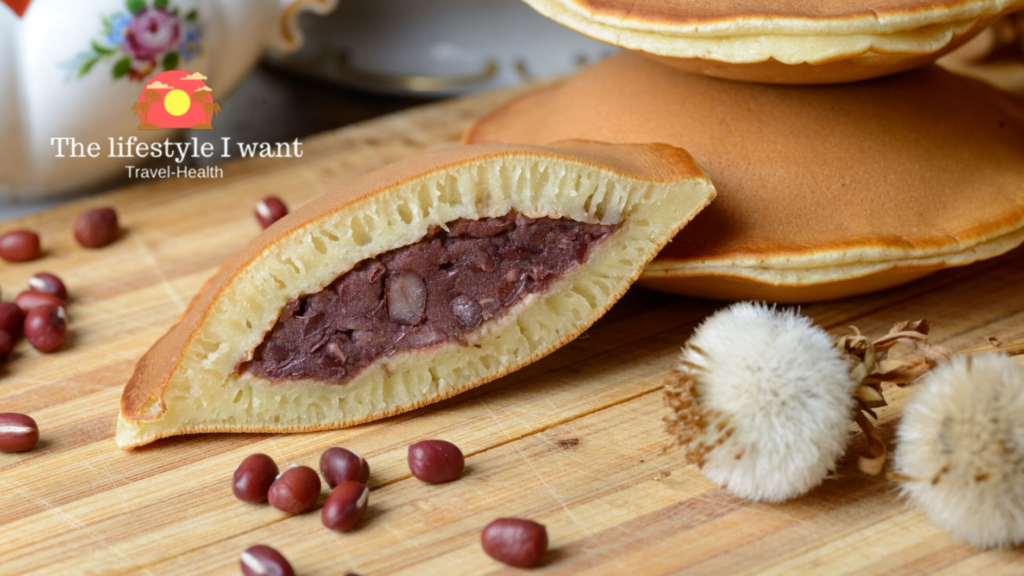
This is very similar to a pancake, with a sweet red beans paste on the inside, it doesn’t taste bad, but I must say I’m not a fan of its flavor.
According to information found in wikipedia, The original Dorayaki consisted of only one layer. Its current shape was invented in 1914 by Usagiya in the Ueno district of Tokyo.
Is Dorayaki Healthy?
Well, this is a very sweet pastry, there’s a lot of sugar in it, white sugar, since we all know how bad white sugar is for our bodies then the answer to the question would be no.
Although, if you’re in the mood for cooking, here’s a healthy Dorayaki recipe I found online
Hope you enjoyed this Japanese food guide.